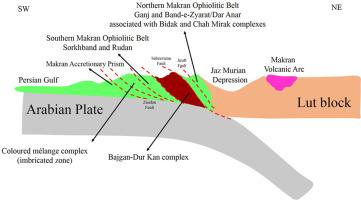伊朗东南部makran地区kahnouj蛇绿杂岩辉长岩全岩地球化学特征及Sr-Nd-Pb同位素特征:岩石成因及其构造意义
IF 2.2
4区 地球科学
Q2 GEOSCIENCES, MULTIDISCIPLINARY
引用次数: 0
摘要
基于新的辉长岩Sr-Nd-Pb同位素和岩石地球化学资料,结合Kahnouj蛇绿岩资料,提出了Kahnouj蛇绿岩杂岩的构造模型。Kahnouj蛇绿杂岩是马克兰带最大的蛇绿岩,由各向同性层状辉长岩组成,底部为超镁铁质透镜体和片状脉,顶部为玄武岩和上层灰岩。各向同性、层状辉长岩的旋回演替表明,早期橄榄石、斜长石结晶→斜辉石结晶→角闪石结晶的分异趋势明显。晶体分馏和部分熔融过程也可以通过全岩地球化学数据推断出来(例如,由Al2O3/TiO2与Ti/1000图记录的分馏)。地球化学上,辉长岩呈亚碱性,具有拉斑岩特征。εNd值为+8.1 ~ +9.2,初始87Sr/86Sr比值为0.70346 ~ 0.70371,表明辉长岩为MORB源。层状各向同性辉长岩的全岩地球化学特征表明,它们形成于弧后盆地环境,代表了早白垩世新特提斯洋的moro -超俯冲型蛇绿岩。本文章由计算机程序翻译,如有差异,请以英文原文为准。

Whole-rock geochemistry and Sr-Nd-Pb isotope characteristics of gabbros from kahnouj ophiolitic complex (SE Iran) in the makran zone: Petrogenesis and tectonic implication
Based on new Sr-Nd-Pb isotopic and lithogeochemical data from gabbros, combined with previously published data from the Kahnouj ophiolite, we propose a tectonic model for the Kahnouj ophiolitic complex. The Kahnouj ophiolitic complex is the largest ophiolite of the Makran zone and consists of isotropic and layered gabbros with ultramafic lenses at the bottom and sheeted dikes, and basalts and pelagic limestones at the top. A cyclic succession of isotropic and layered gabbros indicates a distinct differentiation trend of early olivine and plagioclase crystallization followed by clinopyroxene and finally hornblende crystalize. Crystal fractionation and partial melting processes are also inferred by whole-rock geochemical data (e.g., fractionation recorded by the Al2O3/TiO2 versus Ti/1000 diagram). Geochemically, the gabbros are subalkaline and show tholeiitic features. The εNd values of +8.1 to +9.2 and initial 87Sr/86Sr ratios of 0.70346–0.70371 indicate a MORB source for the gabbros. The whole-rock geochemistry of the layered and isotropic gabbros suggests that they formed in a back-arc basin setting and represent MOR-to supra-subduction type ophiolites in the Neotethys Ocean during Early Cretaceous.
求助全文
通过发布文献求助,成功后即可免费获取论文全文。
去求助
来源期刊

Journal of African Earth Sciences
地学-地球科学综合
CiteScore
4.70
自引率
4.30%
发文量
240
审稿时长
12 months
期刊介绍:
The Journal of African Earth Sciences sees itself as the prime geological journal for all aspects of the Earth Sciences about the African plate. Papers dealing with peripheral areas are welcome if they demonstrate a tight link with Africa.
The Journal publishes high quality, peer-reviewed scientific papers. It is devoted primarily to research papers but short communications relating to new developments of broad interest, reviews and book reviews will also be considered. Papers must have international appeal and should present work of more regional than local significance and dealing with well identified and justified scientific questions. Specialised technical papers, analytical or exploration reports must be avoided. Papers on applied geology should preferably be linked to such core disciplines and must be addressed to a more general geoscientific audience.
 求助内容:
求助内容: 应助结果提醒方式:
应助结果提醒方式:


